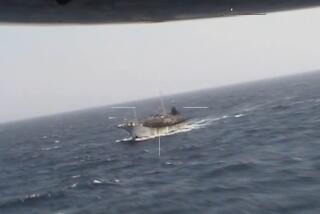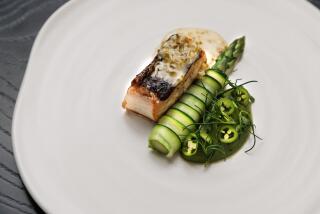These Little Boats Are Finding the Big Fish as Anglers Discover Intimacies of Their Sport : Having a Pang for the <i> Pangas</i>
- Share via
SAN JOSE DEL CABO, Mexico — Autumn marks the arrival of big-time fishermen who come here to catch big-time fish, primarily the blue marlin that frequent the Mexican waters this time of year. Anglers’ express purpose is catching one of these prized billfish.
So, scores of cruisers work the sea daily, as if trying to locate a hidden treasure. It’s a marlin-sweeping operation of gigantic proportions, particularly outside the Cabo San Lucas Marina.
Out to sea and back, weaving and turning in every direction, they cover as much territory as possible. Should there be a sighting by more than one boat, a mad scramble to the scene ensues.
Otherwise, these fishermen usually sit about the deck, picking at box lunches, occasionally gazing off the stern at the trolled lures set out to attract the fish.
They talk. They wait. They hope.
Meanwhile, a small fleet of open motorboats--called pangas-- is en route to an area closer to shore, roughly 2 miles offshore and 5 miles north of Palmilla Beach, where yellowfin tuna have been feeding.
Dorado were seen in the area as well. So were the sleek and powerful wahoo. Even the prized marlin were seen, and caught, here.
These fishermen, though, differ greatly from their counterparts in the cruisers who troll the outer waters for marlin. These fishermen coast into an area and fish quietly as one would from a skiff in a lake, although what they are fishing is often described as “the world’s greatest fish trap.”
“It’s the best way to fish,” said Pat Barty, here on his annual vacation from Lompoc. And as he said it, he was struggling to land a 25-pound yellowfin tuna. “I haven’t fished on the cruisers in a long time. It’s just not worth the expense versus what you can catch.”
The cost of a day’s fishing aboard a panga-- from $100 to $125 a boat--is about one-third that of a cruiser. Pangas will hold two, sometimes three, passengers and fishermen are accompanied by one or two guides.
Barty, like most of the 40 or so anglers fishing on a hot November morning in the Sea of Cortez, caught several yellowfin tuna before the sun was overhead. Double hookups were common, and on some occasions, a guide would hook into a third and hand the rod to the first passenger to reel his in, laughing as the exhausted fisherman battled the powerful tuna in rapid succession.
“It’s the first time in my life I actually wished my bait wouldn’t get hit,” one fisherman said after catching a half-dozen or so tuna at 15 minutes a shot, his arms hanging limp at his side.
By noon, most of the boats, their holds already full, were returning to Palmilla Beach, where their catches--mostly yellowfin tuna in the 20- to 50-pound class--would be filleted or steaked by ambitious young Mexicans.
It was business as usual in Baja California Sur, where fishing means everything. Fishing from pangas, most say, is a pleasant alternative that is often more productive and requires less waiting than on the larger cruisers.
A look at the scrapbook in the office of Victor’s Sportfishing--at the Posada Real Hotel--reveals some of Victor Gutierrez’s customers’ more impressive catches: a 200-pound yellowfin tuna, a 350-pound blue marlin, a 121-pound amberjack, colorful dorado in all sizes. All caught on 1 of his 21 pangas, which depart daily at dawn off sandy Palmilla Beach.
“People fish pangas because it’s the best way to fish,” said Gutierrez, who has been in business here for 8 years. “The anglers have more participation--and they do not sit in a chair all day. It’s very relaxing for them. Most are return customers who keep the same skipper each time.”
Ken Allen, a regular from Newport Beach, said: “It’s the best way to go under any conditions. And you get more intimate with the fish.”
His fishing partner, Hank Schoubye, said: “It’s a little over a third of the cost to fish on the pangas. Besides, the pangas are faster and can get right to where the fish are. And you can catch the same thing: marlin, wahoo, dorado.”
And although some figure that they may have a greater chance at catching the bigger of these species on a bigger boat--most pangas are 22 feet long--others know better.
Just ask Dana P. Mann, a resident of Puyallup, Wash., who comes here once a year to get away from his 12-hours-a-day marine maintenance job and to relax and fish in an arid setting.
Mann, who fishes for halibut a couple of times a month at home, has made the switch to pangas because “You get more involved. It’s more of a one-on-one situation,” he said.
This autumn, Mann, 33, went one on one with a 750-pound black marlin, which he hooked at Gorda Banks 5 miles off Palmilla and caught 3 1/2 hours later after having been towed by the billfish to an area 9 miles offshore.
He and his wife were fishing with light tackle and catching nothing but bonito, so the panga’s skipper rigged a rod and reel with 50-pound-test line and tossed it out.
“The next thing I knew, (the guide) was yanking on the pole setting the hook,” Mann said. “He got the motor started up and handed the rod to me. I tried to hand it to my wife, but he said, ‘No, senor. You.’ So I took the rod and half the line was already gone.
“For the first hour and a half, I didn’t see it. It just sounded and was pulling us around continuously, further out into the Sea of Cortez.
“I finally started to get some line back and I felt the thing coming up.”
Mann said the huge marlin exploded out of the water 50 yards from the boat and tail-walked for about 10 yards while attempting to shake the hook.
“It then went back down and I didn’t see it for another hour,” he said. “After 2 1/2 hours we were both getting tired--I’d pump with one arm and rest the other. Finally, after 3 hours, it was flat tired, about three-quarters dead and I was feeling about the same.”
Mann and the two guides managed to haul the giant marlin into the panga, which made the lopsided journey back to the beach, a bill rising from the bow, a tail from the stern.
Panga fishing is not new to Mexico. The small boat has been the primary vessel of Mexican commercial fishermen for decades. Over the years, however, more and more of the fishermen who use pangas are catering to the growing number of tourists who come here during the cooler months, and resuming their commercial activities during the hotter summer months.
“Most of the guides come from La Playa,” on the northern edge of San Jose del Cabo, Gutierrez said. “Everybody is a fisherman there-- all are commercial fishermen.”
There are three sizable fleets--of 20 pangas or more--in the San Jose area, and seven farther south at Cabo San Lucas, according to Gutierrez. Several independent operators can be found at either area and at various points between, which makes booking a boat on any given day a simple task. Most hotels will direct prospective fishermen.
Preparations begin at dawn, mostly along such powder-sand stretches of beach as La Playa or Palmilla. Mexican fishermen cast nets into the surf, which are then hauled in filled with bait--sardines and mullet.
Fishermen gather on the beaches at about the same time, finding their guides and drinking their coffee while watching the brilliant sunrise.
Saltwater is splashed into the boats’ live-bait wells, a simple cavity in the aft-section of the boat, and is kept fresh on the bumpy ride out by a guide who methodically bails and refills the tank with a small bucket.
“It’s a low maintenance operation,” Gutierrez admitted.
Then it’s off to find the fish, which, given the abundance of sea life in the Sea of Cortez, usually doesn’t take long. The guides, for the most part, don’t speak English, but little needs to be said. Having a vast knowledge of the area, they know what is biting and where, using landmarks to locate the most popular fishing grounds.
“I’ve been here all my life,” said Julio Zumaya, 20, who runs a panga fleet out of La Playa. “November and December is the best time for wahoo, blue marlin, yellowfin tuna and dorado.”
Zumaya said that on one of his most recent outings, two customers caught 7 wahoo in the 60-pound range in 2 hours. “Another guy caught a 600-pound blue marlin on 50-pound-test after a 6-hour fight,” he said. “It was too big for the boat so we tied it to the side with 100-pound-test (fishing line).”
Said Gutierrez: “People always think, ‘Big boat, big fish.’ The difference (between a cruiser and a panga) is when a person catches a big fish on a panga, the fish drags the panga around and it’s much more fun.”
Ask Dana Mann.
More to Read
Sign up for The Wild
We’ll help you find the best places to hike, bike and run, as well as the perfect silent spots for meditation and yoga.
You may occasionally receive promotional content from the Los Angeles Times.






